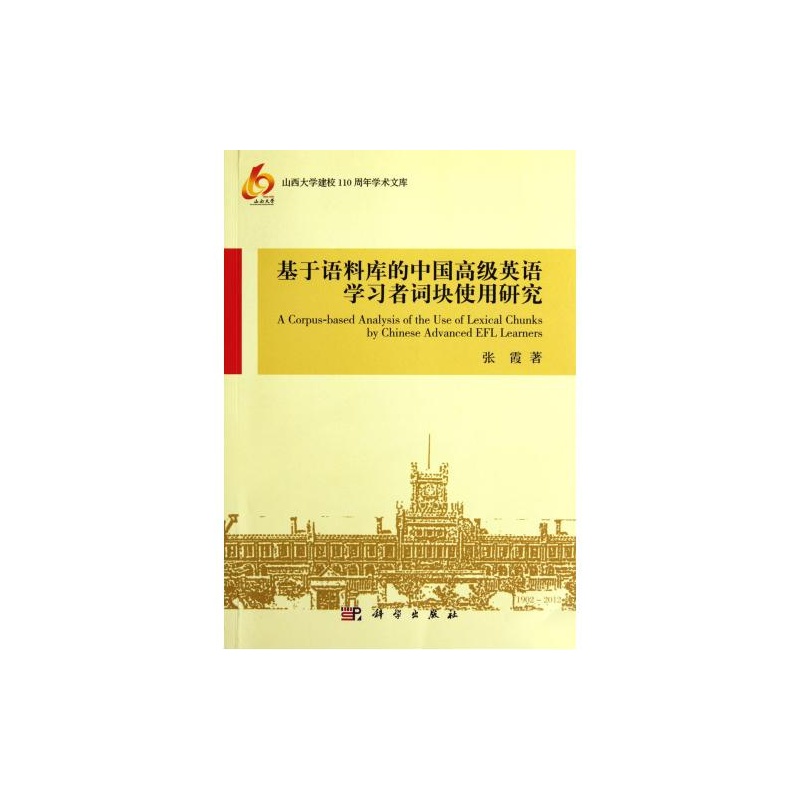基本信息
| 商品名稱: | 基于語料庫的中國高級英語學習者詞塊使用研究/山西大學建校110周年學術文庫 |
| 作者: | 張霞 | 開本: | 16開 |
| 原價: | 48
| 頁數: | 199 |
| 現價: | 39.3 | 出版時間 | 2012-05-01 |
| ISBN號: | 9787030339782 | 印刷時間: | 2012-05-01 |
| 出版社: | 科學 | 版次: | 1 |
| 商品類型: | 圖書 | 印次: | 1 |
內容提要
詞塊集中體現了語言使用中規約性與創新性的辯證統一,詞塊使用特 征往往提示出文本構成的機制以及學習者的語言能力特征。《基于語料庫的中國高級英語學習者詞塊使用研究》(作者張霞)設計了一套行之有效的 詞塊抽取和賦碼方案,并將之應用于中國高級英語學習者詞塊使用的調查分析,從結構功能和詞匯語法兩個層面考察了學習者和本族語者使用詞塊 的趨勢;還對學習者和本族語者、母語不同的學習者、學習者和教材用法進行了對比分析,旨在揭示學習者用法中產生偏差的內在機理,以期對教 學有所啟示。《基于語料庫的中國高級英語學習者詞塊使用研究》適合高校英語教 師、語言學類研究人員、高效在讀語言學類研究生及對語言量化研究感興趣的本科生閱讀。
作者簡介
女,山東章丘人,漢族。山西大學外國語學院教師,上海交通大學博士畢業。主要研究方向為語料庫語言學。
目錄
總序 Acknowledgements Introduction Chapter I Lexical Chunks andLanguage De*ion 1.1 The conventional use of language as along-standing and long-recognized phenomenon 1.1.1 A de facto,long-standing and wide-spread phenomenon 1.1.2 A long recognizedphenomenon 1.2 The centralization of conventional language inneo-Firthian researches 1.2.1 The difference between thefunctionalist and mentalist paradigms 1.2.2 From meaning andfunction to the conventional use of language 1.2.3 How neo-Firthianarguments solve the problem of productivity 1.3 Lexical chunks asrepresenting conventionality in language use 1.3.1 The nature oflexical chunks 1.3.2 Features of lexical chunks 1.4 A review of themethodology development in studies of lexical chunks 1.4.1 Themarginalization of phraseology and the salience approach 1.4.2 Thecentralization of phraseology and the statistical approach 1.4.3Altenberg, Biber and the study of lexical chunks 1.5 SummaryChapter 2 Lexical Chunks and Language Acquisition 2.1 A comparison2.2 Holistic language processing and FLA 2.2.1 Explanatory adequacyand the alternative expediency 2.2.2 Holistic language processingand the route of FLA 2.2.3 The role of holtic language processingin FLA 2.3 Lexical chunks and SLA 2.3.1 Differences andsimilarities between advanced EFL learne and fit language acquiringchildren 2.3.2 Lexical chunks and the route of SLA 2.3.3 Lexicalchunks and the success of SLA--the social-functional level 2.3.4Lexical chunks and the success of SLA--the lexico-grammatical level2.3.5 Lexical chunks and the success of SLA--extant studies 2.4Procedural vocabulary and lexical chunks 2.4.1 The conception ofprocedural vocabulary 2.4.2 The relatiohip between proceduralvocabulary and lexical chunk 2.5 Deviatio in learne' use of lexicalchunks--de*ion and diagnosis 2.5.1 Two kinds of deviatio andtwo approaches to the diagnosis 2.5.2 The CIA approach and thediagnosis of learner deviatio 2.5.3 The research questio of thepresent research 2.6 The acquisition of lexical chunks in theclassroom context 2.7 Summary Chapter 3 The Methodology 3.1 An NLPpepective of the study of lexical chunks 3.1.1 Hybrid algorithms3.1.2 Association measures 3.1.3 Statistical algorithms to decideMWU boundary 3.1.4 Dispeion 3.1.5 The extraction of proceduralvocabulary 3.1.6 The automatic extraction of patter around acertain word 3.2 The methodology of the present study 3.2.1 Corporaused-size, sampling and preprocessing 3.2.2 The extraction oflexical chunks: length range, frequency, dispeion and boundarydetermination 3.2.3 The filtering process 3.2.4 Tools of lexicalchunk extraction 3.2.5 Annotation 3.2.6 The extraction of PV 3.2.7Word-form based lexical chunks and POS-tag sequences around PV 3.3The research design of the present study Chapter 4 Word-form BasedLexical Chunks 4.1 The proportion issue 4.2 Types and toke oflexical chunks in different length categories 4.3 Types, toke andtype/token ratio of lexical chunks in different corpora 4.4 Thestructure and function characteristics of lexical chunks 4.4.1Dependent clause 4.4.2 Independent clause 4.4.3 Single clausecotituent 4.4.4 Incomplete phrase 4.4.5 Multiple clause cotituents4.4.6 The interaction between function and corpus 4.5 Discussionand summary Appendix: Complementary statistical analyses Chapter 5POS-tag Sequences Around PV 5.1 Procedural words in the fourcorpora 5.1.1 Rank correlation analysis 5.1.2 Distribution ofcontent and function words 5.1.3 Distribution of PV of variousparts of speech 5.2 The relatiohip between procedural words andlexical chunks 5.2.1 The proof of the close relatiohip between PVand lexical chunks 5.2.2 De*ive statistics 5.3 proceduralwords common to the corpora under study 5.3.1 Analysis of take5.3.2 Analysis of make 5.3.3 Analysis of time and way 5.4 SummaryAppendix: Complementary statistical analysis Chapter 6 MajorFindings Revisited 6.1 Major findings and conclusio 6.2 Limitatioand prospects 6.2.1 Higher degree of abstractness 6.2.2 Semanticprosody and discoual functio 6.2.3 The developmental dimeion 6.2.4Procedural vocabulary References Appendix


